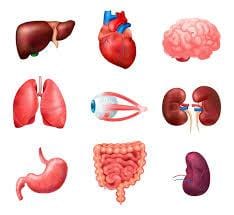Cells, tissues, organs and organ systems | Year 7 Biology (Cambridge) PDF Download
| Table of contents |

|
| Organelles |

|
| Cells |

|
| Tissues |

|
| Organs |

|
| Conclusion |

|
Organelles
Organelles, also called subcellular structures, are the parts that make up a cell.
Examples of organelles include:
- Nucleus: Contains the cell's genetic material and controls its activities.
- Ribosomes: Produce proteins for the cell.
- Mitochondria: Generate energy for the cell through respiration.
Each organelle has a specific role, and together they form a single cell.
Cells
Cells are the basic building blocks of life. They come in various shapes and sizes and contain different combinations of organelles.
Specialized cells include:
- Epithelial cells: Cover surfaces of the body like the skin.
- Muscle cells: Contract and relax to allow movement.
- Glandular cells: Produce and release substances like enzymes and hormones.
Tissues
A tissue is a group of similar cells that work together to carry out a particular function.
Examples of tissues include:
- Epithelial tissue: Formed by epithelial cells to cover body surfaces.
- Muscle tissue: Formed by muscle cells to enable movement.
- Glandular tissue: Formed by glandular cells to produce and secrete substances.
Organs
An organ is a group of different tissues that work together to perform a particular function.
Examples of organs include:
- Stomach: Made of epithelial, muscular, and glandular tissues to kill microorganisms and break down proteins.
- Liver: Performs various functions including detoxification and protein synthesis.
- Pancreas: Produces enzymes for digestion and hormones like insulin.

Organ Systems
An organ system is a group of organs that work together to perform a particular function.
Examples of organ systems include:
- Digestive system: Includes the stomach, pancreas, liver, and other organs to digest food and absorb nutrients.
- Cardiovascular system: Composed of the heart and blood vessels to circulate blood.
- Reproductive system: Includes organs like the ovaries and testes for producing offspring.
Organism
The highest level of organization is the organism. Multiple organ systems work together to form a complete organism, such as a human.
Examples and Additional Organ Systems
Other examples of organs include:
- Skin: Protects the body and regulates temperature.
- Lungs: Facilitate the exchange of oxygen and carbon dioxide.
- Bones: Provide structure and support to the body.
Additional organ systems include:
- Immune system: Defends against infections.
- Nervous system: Controls and coordinates body activities.
- Respiratory system: Supplies oxygen to the blood and removes carbon dioxide.
- Endocrine system: Produces hormones that regulate various body functions.
- Urinary system: Removes waste products from the body.
Conclusion
Understanding the levels of organization in multicellular organisms helps us appreciate how complex living beings are structured and function. Each level, from organelles to the entire organism, plays a crucial role in maintaining life.
|
7 videos|6 docs|3 tests
|
FAQs on Cells, tissues, organs and organ systems - Year 7 Biology (Cambridge)
| 1. What is the smallest level of organization in living organisms? |  |
| 2. How are tissues formed in the human body? |  |
| 3. Can you provide examples of organs in the human body? |  |
| 4. How do organ systems work together to maintain homeostasis in the body? |  |
| 5. Why is understanding the levels of organization in living organisms important in the field of biology? |  |

|
Explore Courses for Year 7 exam
|

|

















